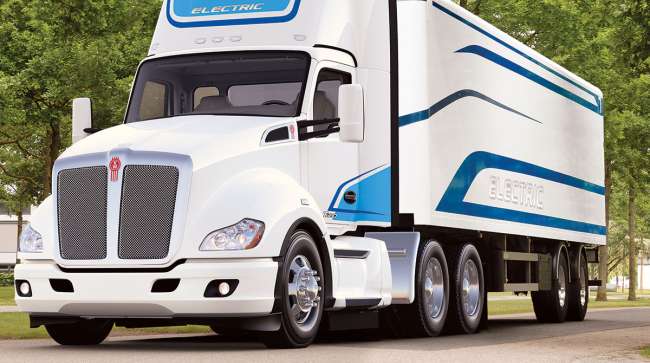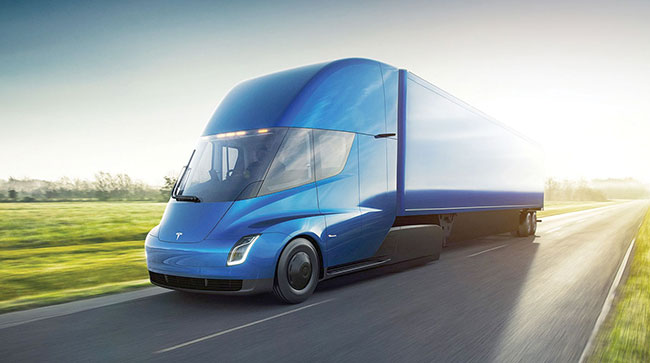Contributing Writer
Paccar Sets Stage for Pure Electric Truck Platform

[Stay on top of transportation news: Get TTNews in your inbox.]
Paccar is in the initial stages of designing a new Class 8 electric truck platform freed from the constraints of having a diesel powertrain and a complex exhaust system.
The platform would complement what the Bellevue, Wash., company uses for its workhorse Kenworth T680, which has diesel, electric and hydrogen fuel cell versions.
“When you start thinking about what you can do with EVs and how to design a chassis, you get to start over,” said Hank Johnson, the brand’s general sales manager for vocational and medium-duty trucks.

Joe Adams, Kenworth’s chief engineer, told Transport Topics that the company is just starting the journey and that customers shouldn’t expect to see the new platform until late this decade or possibly 2030.
But he added that it makes sense to start planning now as the industry is in the very first stages of transitioning to zero-emission tractors.
“You will see the project evolve,” Adams said.
Kenworth is looking at a platform designed specifically for an electric powertrain, powered either by batteries or a hydrogen fuel cell.
“We are just starting to dream differently about what such a truck looks like,” he said.

Host Seth Clevenger, fresh from CES, discusses autonomous and electric trucks with Joe Adams of Kenworth and Cheng Lu of TuSimple. Hear a snippet above, and get the full program by going to RoadSigns.TTNews.com.
It would merge multiple advanced technologies, including a zero-emission powertrain and autonomous driving capability. Adams said autonomy will become increasingly important to augment the driver pool the industry uses today and to fill shortages. And there would be far more connectivity.
“Not having an internal combustion engine and driveline really provides freedom in how you design more interesting and efficient products,” Adams said.
“The way it would look would be set by driving the lowest coefficient of drag. And then, you would create the tires and cab package. But for the next 10 years, trucks will still be designed with a cab for a driver to jump in and dock it,” he said.
That means the new truck will still need steps to get in and out. It will require a fueling or energy port, and it will have headlights and bumpers to comply with federal regulations, Adams said.
But design becomes much more flexible if you are storing electrons or hydrogen when compared to diesel. Battery and hydrogen storage come in all types of shapes and configurations, allowing for better aerodynamics and other creative design features, he said.
Others have tried to build a purely electric truck platform from scratch. Still, the prominent manufacturers, including Daimler Trucks and Volvo Trucks, are leveraging existing platforms for their initial electric Class 8 tractors.
“Free-thinking and rethinking the Class 8 tractor is what Tesla was trying to do with their 2017 reveal,” said Rick Mihelic, director of emerging technologies at the North American Council for Freight Efficiency.

The Tesla Semi is still not in production. (Alexis Georgeson/Tesla Motors)
The prototype of the Tesla cab marked a dramatic design change from mainstream Class 8 tractors built for the U.S. market.
The cab looks like a stormtrooper’s helmet from Star Wars. A single seat is located in the center of a steeply sloping aerodynamic cab. But the futuristic electric truck has encountered multiple development delays. It is still not in production, missing the original 2019 target by a wide margin.
Mihelic said designing a truck from an empty sheet of paper is far more complicated than people realize.
“The required interfaces start imposing themselves quickly. Tires. Trailers. Fifth wheels. Human beings. All of those become interface requirements. Federal rules on required equipment like air brakes, lighting, etc., also impose interface requirements,” he said.
Manufacturers must deal with myriad regulations. The cab needs to match the width and height of the trailer. It must have at least one driver position. There are legal items like headlight height.
Want more news? Listen to today's daily briefing above or go here for more info
“The greatest opportunities are in rethinking the drivetrain. Wires replacing driveshafts open up new choices for packaging the vehicle. No exhaust. No emission systems. No turbochargers. Little heat to deal with. Heat exchangers are easier to package. Crash energy absorption becomes much different without the engine,” he said.
While it is possible that a battery-motor combo could allow for more creative designs, the more significant advantage with a new platform would be its capability to manage a much more robust set of computers and be modifiable via software, said Mike Ramsey, the automotive and smart mobility analyst at Gartner Inc.
“That’s what GM, VW and Ford have done with their new EV light-vehicle platforms,” Ramsey said. “This opens the door to more advanced safety systems and autonomy.”


